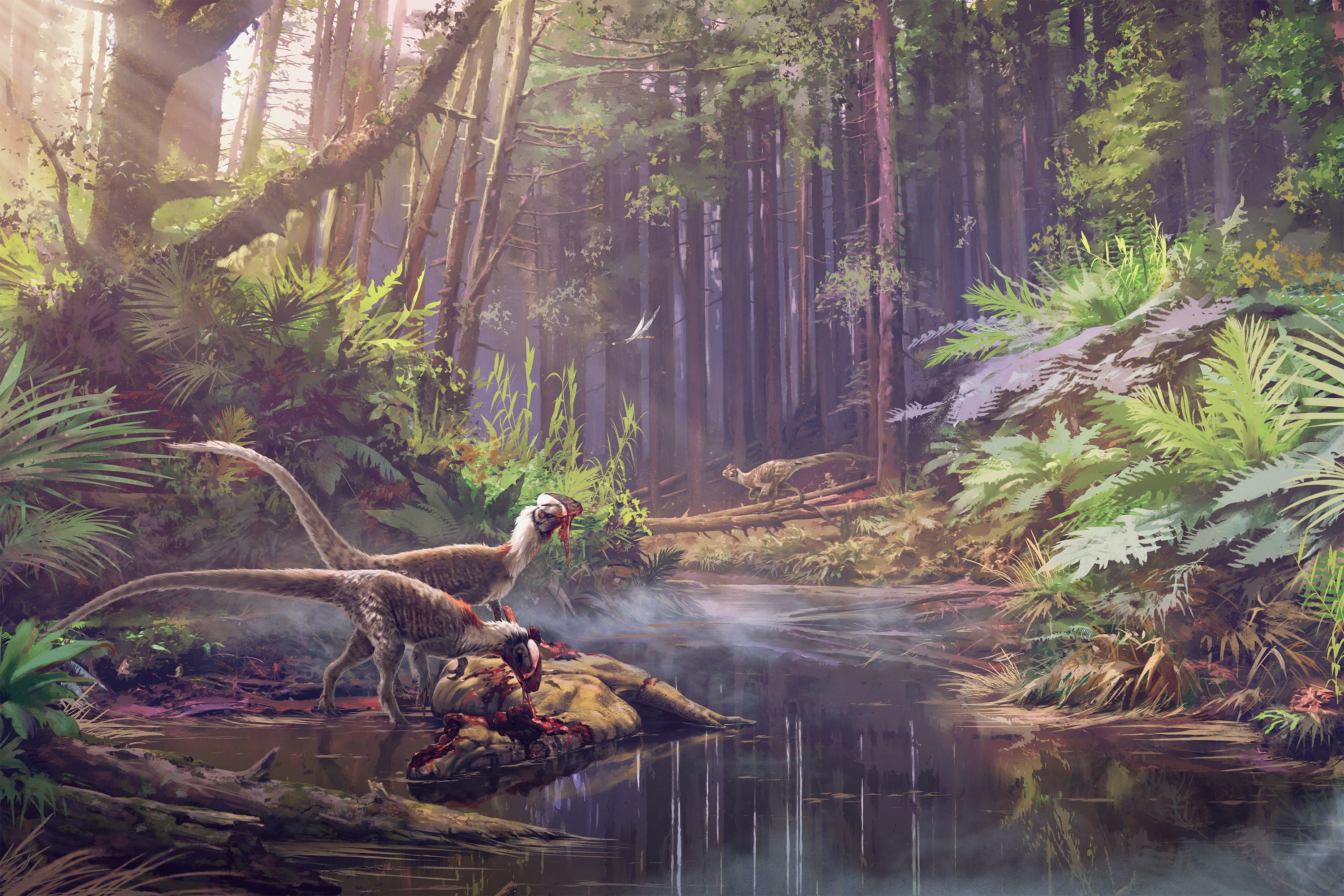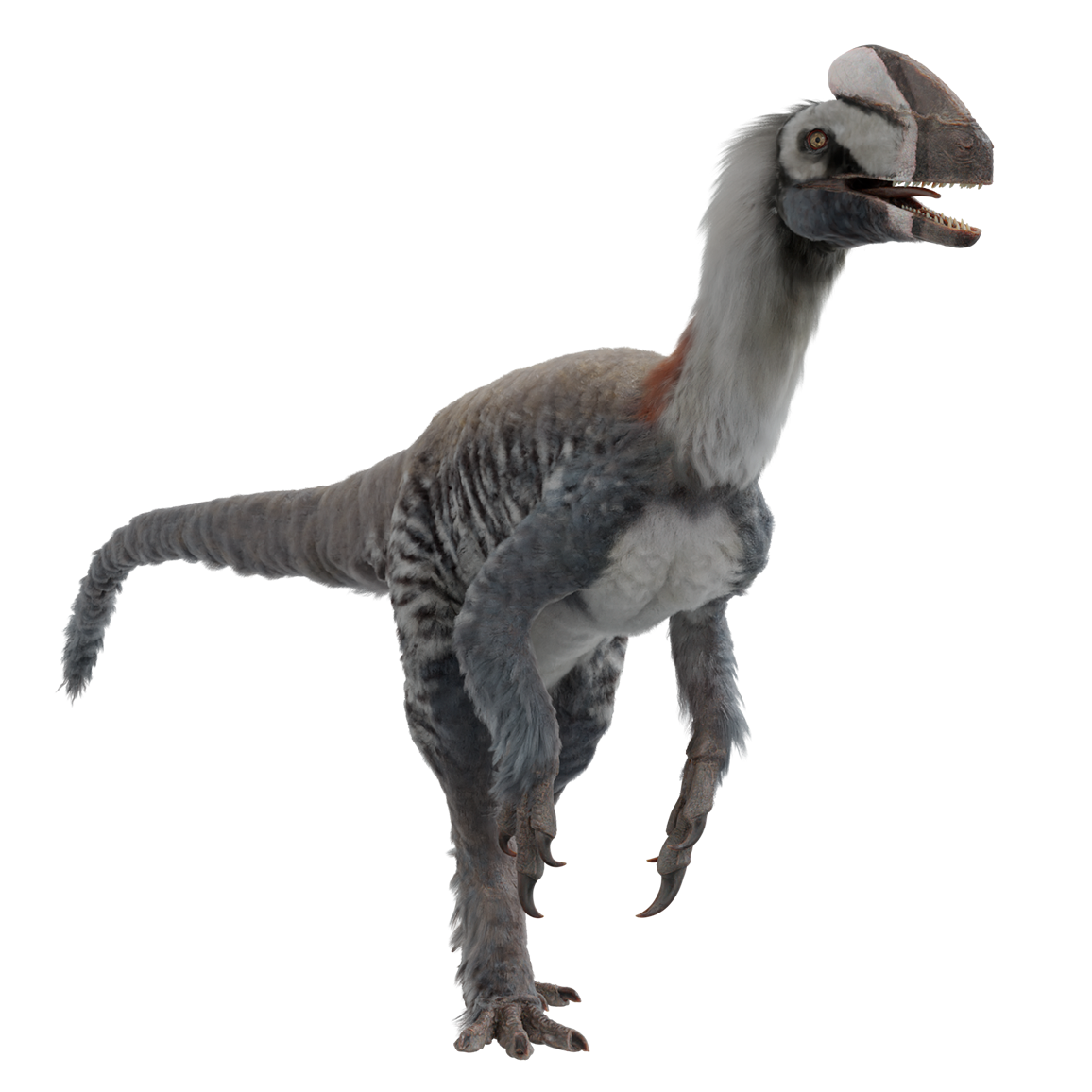The Dawn of the Tyrants
Tyrannosaurs were not always the kings of the Late Cretaceous, having humble beginnings in Jurassic, and among the first of them was Guanlong, a speedy, small-medium sized predator with an ornate nasal crest.
Overview: The tyrannosaurs are among the most famous of all dinosaurs, known as fearsome apex predators that stalked the Late Cretaceous of North America and Eurasia. T. rex, the largest and most famous of them, is often hailed as “the king of the dinosaurs”. But they weren't always the tyrant rulers of the northern hemisphere. They had rather humble beginnings, and among the first of them was the small-medium-sized crested predator Guanlong, discovered in the early 21st Century from the Late Jurassic Shishugou Formation of China. This was a very different sort of animal, lacking the massive jaws, enormous size, and short arms that would define later tyrannosaurs, and it was no apex predator. But it was the forerunner of tyrants and had several traits that would be passed on to later tyrannosaurs which would aid in their becoming the most fearsome terrestrial predators to ever walk the earth.
Discovery: Guanlong wucai was discovered in the Late Jurassic Shishugou Formation of China and was named in 2006 by Xu Xing and coauthors. Its genus name is Chinese, meaning “Crown Dragon”, in reference to the ornate crest on its snout. The species name, wucaii, means "multicoloured" and refers to the rocks of the Wucaiwan, the multi-colored badlands where Guanlong was found. Two specimens were discovered, the holotype (original name bearing specimen used to define a species), which is a partially complete adult, and a second specimen, a nearly complete juvenile.
Evolution and Description: Guanlong was an early member of the clade Tyrannosauroidea which includes the family Tyrannosauridae, as well as their earlier relatives. Within this clade, Guanlong belonged to a very early offshoot family called Proceratosauridae, along with the similarly sized but slightly earlier Proceratosaurus (no actual relation to Ceratosaurus) from England, the somewhat larger Russian Kileskus, and the much larger Sinotyrannus and Yutyrannus from the Early Cretaceous of China. Proceratosaurids had prominent crests on their snouts, downy feathers, long legs, and long arms with three-fingered hands, in stark contrast to the short arms and two-fingered hands of later tyrannosaurs. Guanlong itself was a small-medium sized predator reaching lengths of 3–3.5 m (9.8–11.5 ft) and weighing about 125 kg (276 lb). At a glance, Guanlong didn’t much resemble its more famous tyrannosaurid relatives at all. However, several key features foreshadowed the tyrannosaurs to come. Guanlong had a deep premaxilla bone, giving it a blunt snout, a feature that would be carried on in future tyrannosaurs. It also had proportionally long legs and was a swift runner, another trait shared by later tyrannosaurs. Like later tyrannosaurs, Guanlong had a very long pubis, which would have served as a point for muscle attachments and also would have helped it run fast. And while Guanlong had an overall, much more delicately built skull than later tyrannosaurs, it already had the fused nasal bones that would help contribute to the immensely powerful bites of later tyrannosaurs.

Ecology: Guanlong may have been the forerunner of tyrants, but in its own day it was no king. It would have used its speed to hunt small prey, perhaps early mammals, lizards, and small herbivorous dinosaurs like the early ceratopsian Yinlong. It hunted in the shadow of much larger theropods, namely the 5 meter (16.4 ft) long Monolophosaurus, a theropod with a nasal crest similar to Guanlong’s, but unrelated, and the 7.6-8.8 meter (25-29 ft) allosauroid Sinraptor, which may have been the region’s apex predator, though the even larger Yanchuanosaurus (a close relative of Sinraptor) lived at the same time elsewhere in China and could have also been present in Guanlong’s environment. In short, this small tyrannosaur would have always had to watch its back, and it may have utilized its speed not just for hunting, but also perhaps for fleeing these larger predators.
Extinction and Legacy: It is unknown when or why Guanlong went extinct. Most likely it was replaced by subsequent species of early tyrannosaurs. By the Early Cretaceous, some of Guanlong’s relatives in China began to get big, namely Yutyrannus and Sinotyrannus. Elsewhere, like Guanlong, tyrannosaurs remained in the shadow of the allosauroids. That changed when the allosauroids went extinct around 90 million years ago, which triggered an adaptive response in tyrannosaurs to grow large and take over the role of apex predators across the northern hemisphere, eventually culminating in the tyrannosaurids and the largest, most powerful, and most famous of them all, Tyrannosaurus rex. The original skeletons of Guanlong are held in the Institute of Vertebrate Paleontology and Paleoanthropology in Beijing, China. A life reconstruction of Guanlong can be seen as part of a traveling tyrannosaur evolution exhibit by the Australian Museum in Sydney, Australia. Guanlong made a brief appearance in the 2006 Discovery Channel documentary T. Rex: New Science, New Beast, and in the 2007 National Geographic documentary Dino Death Trap, as well as a highly fictionalized appearance in the 2009 animated film Ice Age: Dawn of the Dinosaurs.
Guanlong FAQ
Guanlong size / How big was Guanlong?
See height, weight, and length.
Guanlong height / How tall was Guanlong?
Guanlong was probably only 1.17 meters (3.84 ft) tall.
Guanlong weight / How much did Daspletosaurus weigh?
Guanlong probably weighed about 125 kg (276 lb).
How long was Guanlong? / Guanlong Length
Guanlong grew to be 3–3.5 m (9.8–11.5 ft) long.
What did Guanlong eat?
Guanlong ate meat, probably early mammals, lizards, and small herbivorous dinosaurs like the early ceratopsian Yinlong.
What is Guanlong closest living relative?
Like all dinosaurs, the closest relatives of Guanlong are the only surviving lineage of dinosaurs today, the birds. Crocodilians, while not dinosaurs themselves, are also more distant cousins of dinosaurs.
Guanlong family members / Guanlong family / What kind of dinosaur was Guanlong?
Guanlong was a theropod (two-legged, mainly carnivorous dinosaurs) in the family Proceratosauridae. Proceratosaurids were among the earliest members of the clade Tyrannosauroidea. Thus Guanlong was a distant ancestor or cousin of the larger and more famous Tyrannosaurus rex!
Where did Guanlong live? / Where was Guanlong found?
Guanlong lived in what is now China.
When did Guanlong live?
Guanlong lived about 168 million years ago during the Middle Jurassic Period.
What does Guanlong mean? / Guanlong name meaning
Guanlong means “Crown Dragon”, in reference to its prominent and ornate nasal crest.

